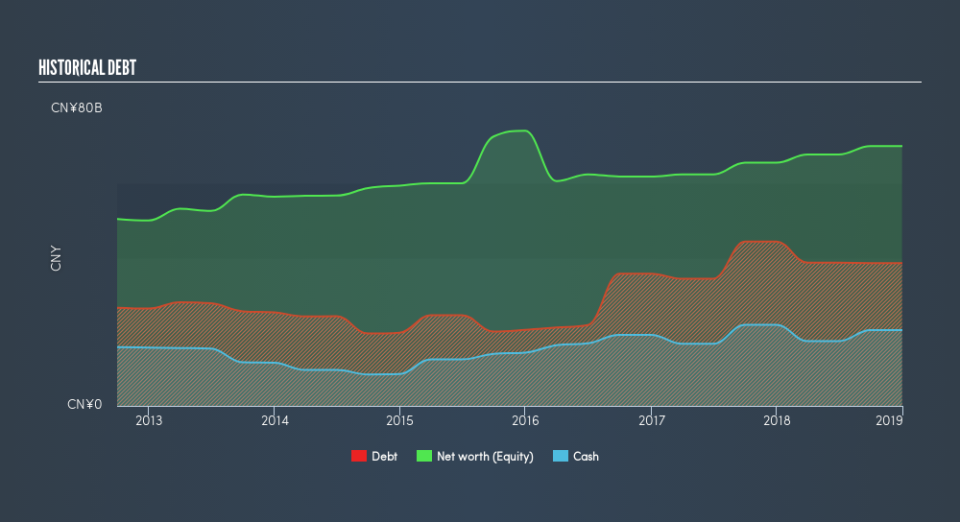Does Kunlun Energy (HKG:135) Have A Healthy Balance Sheet?

David Iben put it well when he said, 'Volatility is not a risk we care about. What we care about is avoiding the permanent loss of capital.' So it might be obvious that you need to consider debt, when you think about how risky any given stock is, because too much debt can sink a company. We note that Kunlun Energy Company Limited (HKG:135) does have debt on its balance sheet. But the real question is whether this debt is making the company risky.
When Is Debt A Problem?
Debt is a tool to help businesses grow, but if a business is incapable of paying off its lenders, then it exists at their mercy. If things get really bad, the lenders can take control of the business. While that is not too common, we often do see indebted companies permanently diluting shareholders because lenders force them to raise capital at a distressed price. By replacing dilution, though, debt can be an extremely good tool for businesses that need capital to invest in growth at high rates of return. When we examine debt levels, we first consider both cash and debt levels, together.
Check out our latest analysis for Kunlun Energy
How Much Debt Does Kunlun Energy Carry?
You can click the graphic below for the historical numbers, but it shows that Kunlun Energy had CN¥38.5b of debt in December 2018, down from CN¥44.7b, one year before. On the flip side, it has CN¥20.5b in cash leading to net debt of about CN¥18.1b.
How Healthy Is Kunlun Energy's Balance Sheet?
We can see from the most recent balance sheet that Kunlun Energy had liabilities of CN¥39.1b falling due within a year, and liabilities of CN¥31.4b due beyond that. On the other hand, it had cash of CN¥20.5b and CN¥5.48b worth of receivables due within a year. So its liabilities total CN¥44.5b more than the combination of its cash and short-term receivables.
This is a mountain of leverage relative to its market capitalization of CN¥51.4b. Should its lenders demand that it shore up the balance sheet, shareholders would likely face severe dilution.
In order to size up a company's debt relative to its earnings, we calculate its net debt divided by its earnings before interest, tax, depreciation, and amortization (EBITDA) and its earnings before interest and tax (EBIT) divided by its interest expense (its interest cover). This way, we consider both the absolute quantum of the debt, as well as the interest rates paid on it.
Kunlun Energy has a low net debt to EBITDA ratio of only 0.98. And its EBIT covers its interest expense a whopping 14.9 times over. So you could argue it is no more threatened by its debt than an elephant is by a mouse. Also good is that Kunlun Energy grew its EBIT at 13% over the last year, further increasing its ability to manage debt. The balance sheet is clearly the area to focus on when you are analysing debt. But it is future earnings, more than anything, that will determine Kunlun Energy's ability to maintain a healthy balance sheet going forward. So if you want to see what the professionals think, you might find this free report on analyst profit forecasts to be interesting.
Finally, while the tax-man may adore accounting profits, lenders only accept cold hard cash. So the logical step is to look at the proportion of that EBIT that is matched by actual free cash flow. Looking at the most recent three years, Kunlun Energy recorded free cash flow of 43% of its EBIT, which is weaker than we'd expect. That weak cash conversion makes it more difficult to handle indebtedness.
Our View
On our analysis Kunlun Energy's interest cover should signal that it won't have too much trouble with its debt. But the other factors we noted above weren't so encouraging. For example, its level of total liabilities makes us a little nervous about its debt. We would also note that Gas Utilities industry companies like Kunlun Energy commonly do use debt without problems. Looking at all this data makes us feel a little cautious about Kunlun Energy's debt levels. While we appreciate debt can enhance returns on equity, we'd suggest that shareholders keep close watch on its debt levels, lest they increase. Given Kunlun Energy has a strong balance sheet is profitable and pays a dividend, it would be good to know how fast its dividends are growing, if at all. You can find out instantly by clicking this link.
When all is said and done, sometimes its easier to focus on companies that don't even need debt. Readers can access a list of growth stocks with zero net debt 100% free, right now.
We aim to bring you long-term focused research analysis driven by fundamental data. Note that our analysis may not factor in the latest price-sensitive company announcements or qualitative material.
If you spot an error that warrants correction, please contact the editor at editorial-team@simplywallst.com. This article by Simply Wall St is general in nature. It does not constitute a recommendation to buy or sell any stock, and does not take account of your objectives, or your financial situation. Simply Wall St has no position in the stocks mentioned. Thank you for reading.


